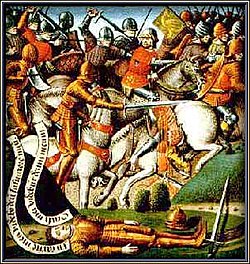Battle of Roncesvalles
| Battle of Roncevaux Pass | |||||||
|---|---|---|---|---|---|---|---|
| Part of Charlemagne's campaign in the Iberian Peninsula | |||||||
 15th century anonymous painting of the Battle of Roncevaux Pass. |
|||||||
|
|||||||
| Belligerents | |||||||
| Franks | Basques | ||||||
| Commanders and leaders | |||||||
|
Charlemagne Roland † |
Unknown (speculated: Lupo II of Gascony) |
||||||
| Strength | |||||||
| 3,000 soldiers who were crossing the pass (Modern est.) | Unknown but large | ||||||
| Casualties and losses | |||||||
| All the men in the rearguard were killed. | Unknown | ||||||
The Battle of Roncevaux Pass (French and English spelling, Roncesvalles in Spanish, Orreaga in Basque) in 778 saw a large force of Basques ambush a part of Charlemagne's army in Roncevaux Pass, a high mountain pass in the Pyrenees on the present border between France and Spain, after his invasion of the Iberian Peninsula.
The Basque attack was a retaliation for Charlemagne's destruction of the city walls of their capital, Pamplona. As the Franks retreated across the Pyrenees back to France, the rearguard of Frankish lords was cut off, stood its ground, and was wiped out. Roncevaux was Charlemagne's only military defeat.
The battle elevated the relatively obscure Roland and the paladins into legend, becoming the quintessential role model for knights and also greatly influencing the code of chivalry in the Middle Ages. There are numerous written works about the battle, some of which change and exaggerate events. The battle is recounted in the 11th century The Song of Roland, the oldest surviving major work of French literature, and in Orlando Furioso, one of the most celebrated works of Italian literature. Modern adaptations of the battle include books, plays and works of fiction, and monuments in the Pyrenees.
With the rise of the Carolingians and Pepin the Short's war on Aquitaine, the Duchy of Aquitaine led by Waifer was defeated and further ensued Frankish penetration into the duchy. The Basques (Vascones, Wascones) of the Duchy of Vasconia, one of the mainstays of the Aquitanian army, submitted to Pepin in 766 and 769, but the territory south of the Garonne remained largely unscathed and self-governed. However, as of 778 Charlemagne expanded Frankish takeover of Aquitaine to present-day Gascony, by appointing trusted Franks, Burgundians and Church officials in key regional positions and establishing counties, such as Fezensac, Bordeaux, and Toulouse, on the left bank of the Garonne.
...
Wikipedia
